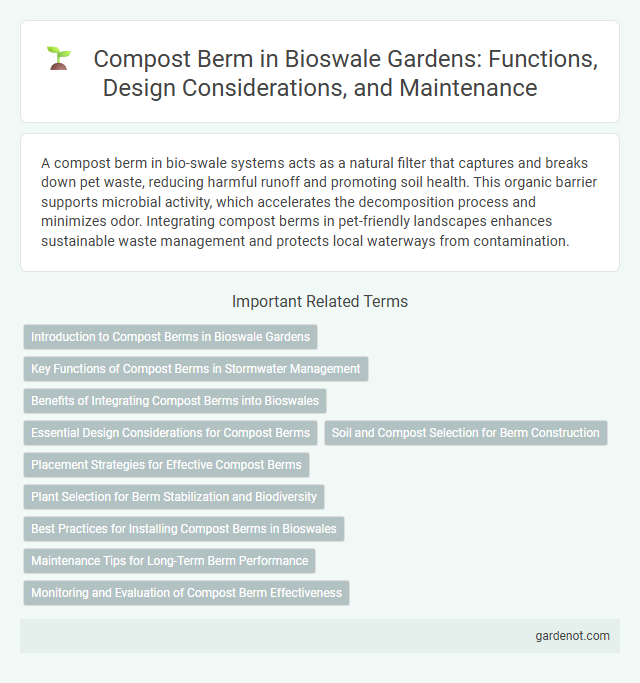A compost berm in bio-swale systems acts as a natural filter that captures and breaks down pet waste, reducing harmful runoff and promoting soil health. This organic barrier supports microbial activity, which accelerates the decomposition process and minimizes odor. Integrating compost berms in pet-friendly landscapes enhances sustainable waste management and protects local waterways from contamination.
Introduction to Compost Berms in Bioswale Gardens
Compost berms in bioswale gardens serve as natural barriers that enhance water infiltration and filter pollutants, promoting healthier stormwater management. These berms, composed of nutrient-rich compost, improve soil structure and support microbial activity essential for breaking down contaminants. Integrating compost berms into bioswales optimizes nutrient cycling and reduces erosion, fostering sustainable urban landscaping.
Key Functions of Compost Berms in Stormwater Management
Compost berms serve as effective natural filters that slow down and absorb stormwater runoff, reducing sediment and pollutant load entering water bodies. Their porous structure enhances infiltration, promoting groundwater recharge while preventing soil erosion in bio-swale systems. By retaining nutrients and organic matter, compost berms improve water quality and support sustainable stormwater management practices.
Benefits of Integrating Compost Berms into Bioswales
Integrating compost berms into bioswales enhances stormwater management by increasing infiltration rates and reducing runoff volume, thus minimizing erosion and pollutant transport. Compost berms improve soil structure and microbial activity, promoting healthier plant growth and natural filtration processes. This sustainable approach boosts the effectiveness of bioswales in mitigating urban runoff while supporting soil restoration and water quality improvement.
Essential Design Considerations for Compost Berms
Compost berms must be designed with optimal permeability to ensure efficient water infiltration while preventing runoff. Selecting high-quality organic materials with appropriate carbon-to-nitrogen ratios enhances microbial activity, accelerating composting and nutrient cycling. Proper placement and sizing based on watershed area and flow volume are critical to maximize pollutant filtration and support sustainable stormwater management.
Soil and Compost Selection for Berm Construction
Selecting nutrient-rich, well-decomposed compost with a balanced C:N ratio of 20:1 to 30:1 enhances the bio-swale's soil filtration capacity and supports microbial activity in compost berm construction. Incorporating native soil with good drainage and moderate texture ensures structural stability and facilitates water infiltration within the berm. Properly blended compost and soil mixtures promote erosion control and optimize pollutant attenuation while maintaining plant health in bio-swale systems.
Placement Strategies for Effective Compost Berms
Proper placement of compost berms is crucial for maximizing their effectiveness in bio-swale systems. Positioning berms along contour lines helps slow runoff, promoting infiltration and sediment capture while preventing erosion. Utilizing site-specific topography and soil conditions ensures berms intercept and treat stormwater efficiently, enhancing nutrient filtration and groundwater recharge.
Plant Selection for Berm Stabilization and Biodiversity
Compost berms in bioswales require strategic plant selection to ensure berm stabilization and enhance biodiversity, prioritizing deep-rooted native species that improve soil structure and prevent erosion. Selecting diverse, drought-tolerant plants supports habitat complexity, attracting pollinators and beneficial insects while promoting resilience to fluctuating moisture conditions. Integrating herbaceous perennials and grasses such as switchgrass, sweetgrass, and coneflowers optimizes nutrient cycling and maintains berm integrity throughout seasonal changes.
Best Practices for Installing Compost Berms in Bioswales
Proper installation of compost berms in bioswales involves selecting high-quality, mature compost with balanced moisture content to enhance filtration and nutrient absorption. Position compost berms strategically along the slope of the bioswale to slow runoff, promote infiltration, and prevent soil erosion. Regular maintenance includes monitoring berm integrity, replenishing compost annually, and removing debris to sustain optimal stormwater management and soil health.
Maintenance Tips for Long-Term Berm Performance
Compost berm maintenance involves regular inspection to prevent degradation and ensure optimal water filtration. Removing accumulated debris and replenishing compost material supports microbial activity essential for pollutant breakdown. Consistent moisture monitoring and erosion control preserve the berm's structure and enhance long-term stormwater management performance.
Monitoring and Evaluation of Compost Berm Effectiveness
Monitoring and evaluation of compost berm effectiveness involve regularly assessing parameters like water infiltration rates, nutrient retention, and sediment capture within bio-swales. Data collected through soil moisture sensors, nutrient analysis, and visual inspections help determine the berm's contribution to runoff reduction and pollutant filtration. Consistent evaluation ensures optimal compost quality and berm design adjustments for maximizing environmental benefits.
Compost berm Infographic

 gardenot.com
gardenot.com